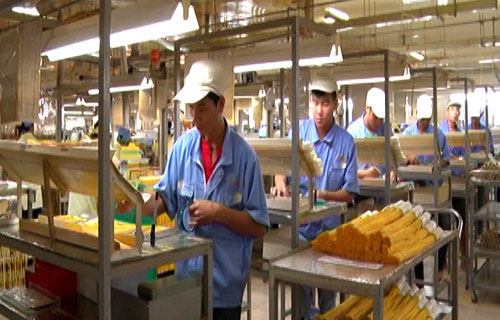
(HBO) - As all the socio-economic fields are severely hurt by the COVID-19 pandemic, many businesses have halted operations or narrowed down production. FDI firms in Hoa Binh province have been striving to overcome the challenges by prioritising disease prevention while applying measures to mitigate the impact of the pandemic.
They have also capitalised on chances for quick recovery and
to bolster production, contributing to the provincial socio-economic development.

Sankoh Vietnam has created stable jobs for over 500
labourers in Lac Son district thanks to expanding production scale.
After six years of operation at Luong Son industrial park,
Coasia CMVINA, a company invested by the Republic of Korea, is creating stable jobs
for 2,300 workers with a monthly income of about 8 million VND per person.
The firm earned 200 million USD each year from exports,
accounting for one-third of Hoa Binh’s export values. It specialises in
producing camera for Samsung smart phones, with production materials being transported
by air.
However, international flights have been frozen in the past
three months due to COVID-19, causing losses of 40 percent to the company in
its output compared to the same period last year.
Despite difficulties, the firm has effectively carried out
dual targets of battling the pandemic and maintaining operation. At the moment,
it is recruiting additional 500 workhands to expand production scale.
The firm still faces double obstacles in material shortage
as well as consumption and exports. To rise over the challenge, it has taken
initiative in seeking the supply of material and new technologies, ensuring
environmental protection and medical services towards achieving a year-on-year
growth of 20 percent.
Sankoh Vietnam, a Japan-invested firm at the industrial park
on the left bank of the Da River, has generated stable jobs for 1,150 local
workers. Its main products include sensors in household appliance of
automobile’s air conditioners, refrigerators, air conditioners and batteries.
The firm has strived to maintain operation and social
welfare activities, such as arranging pickup vehicles and childcare services
for workers. It also opened a new factory in Lac Son district to expand production
and create more jobs for local people./.
According to data from the Hoa Binh Provincial Party Committee, the industrial production index for the first six months of 2025 is estimated to have increased by 20% compared to the same period last year. This marks the highest year-on-year growth rate for this period since 2020.
In the first six months of 2025, Hoa Binh province’s export turnover was estimated at 1.145 billion USD, marking an 18.11% increase compared to the same period in 2024. Import turnover was estimated at $ 804 million, a 17.15% increase, which helped the province maintain a positive trade balance.
The lives of the ethnic minority farmers in Tan Lac district have gradually improved thanks to the new directions in agricultural production. This is a testament to the collective strength fostered through the professional associations and groups implemented by various levels of the district’s Farmers’ Union.
With the motto the "product quality comes first,” after nearly one year of establishment and operation, Muong village’s Clean Food Agricultural and Commercial Cooperative, located in Cau Hamlet, Hung Son Commune (Kim Boi district), has launched reputable, high-quality agricultural products to the market that are well-received by consumers. The products such as Muong village’s pork sausage, salt-cured chicken, and salt-cured pork hocks have gradually carved out a place in the market and they are on the path to obtaining the OCOP certification.
In the past, the phrase "bumper harvest, rock-bottom prices" was a familiar refrain for Vietnamese farmers engaged in fragmented, small-scale agriculture. But today, a new spirit is emerging across rural areas of Hoa Binh province - one of collaboration, organisation, and collective economic models that provide a stable foundation for production.
Maintaining growing area codes and packing facility codes in accordance with regulations is a mandatory requirement for agricultural products to be eligible for export. Recently, the Department of Agriculture and Environment of Hoa Binh province has intensified technical supervision of designated farming areas and packing facilities to safeguard the "green passport" that enables its products to access international markets.



